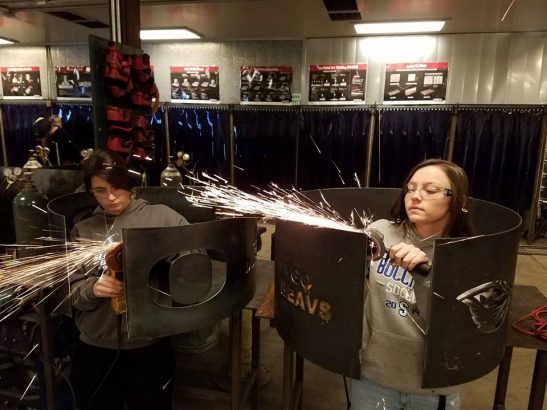Great CTE-xpectations: Inside Oregon’s New $170 Million Bet for Boosting One of the Worst Graduation Rates in the Nation

Carlos Lopez spent most of his senior year in one classroom, obscured in orange sparks, large goggles, and yellow gloves. The 2017 graduate was preparing for a career in welding, something he had wanted to do since he watched his father work as a fabricator in southwestern Oregon.
Luckily for Lopez, he attended one of the several dozen high schools in the state that have received career and technical education revitalization grants in a statewide effort to bring back vocational classes that have slowly disappeared since 2000. Lopez was able to build everything in class from garden plant hangers to a hydraulic dump trailer that can haul 14,000 pounds. He now works as a fabricator while studying welding at his local community college.
Ask Lopez to envision his high school experience without CTE, and he remembers the beginning, when he was earning C’s. “But when I found out that to be a welder, you have to have good math grades, that’s when I started to bump them up,” said Lopez, who was earning A’s and B’s by the time he walked across the stage this spring to receive his diploma. “I probably wouldn’t have done so well because I wouldn’t have wanted to be so much a part of everything.”
This power CTE has to inspire student engagement is something Oregonians want for far more high schools, hoping in part that CTE classes can improve their state’s graduation rate, which has been one of the worst in the nation for the past five years. That’s why last fall, two-thirds of Oregon voters said yes to Measure 98, an initiative that proposed improving high school completion rates by giving out hundreds of millions of dollars for districts to build three areas: dropout prevention, college readiness, and career and technical education.
Of the three goals, CTE seems to have spurred the most excitement among educators, who see it as a dropout prevention tool in its own right by making school meaningful and relevant. Precarious budgets and a shift toward college prep as the focus of secondary education, they say, have wiped out CTE, leaving behind students who would have thrived with vocational training.
“Not every kid enjoys sitting and learning from a textbook,” said Stephen Phillips, deputy superintendent of the Beaverton School District. “Some kids learn differently. They learn by trial and error. They learn by bloodying their knuckles under the hood of a car.”
Oregon school district graduation rates and estimated Measure 98 funds
But the law as it stands is giving schools only about half of what voters had hoped for under Measure 98. Finding the funding amid a billion-dollar state budget deficit proved challenging for legislators, and a separate ballot measure that would have created a revenue source for education and health care failed.
Despite this, educators hope the two-year, $170 million allocation that legislators did approve, starting this fall, will boost the statewide graduation rate. Overall, it stood at 75 percent in 2016 — up from 66 percent in 2010, but still well below the national average of 83 percent.
But Oregon students who take CTE courses earn diplomas at a rate of 90 percent, a full 15 percentage points above the state average.
District leaders believe that expanding CTE offerings will bump up those statewide numbers, a contention backed up by a report last year from the Thomas B. Fordham Institute. The data showed that students who earn CTE credits are more likely to graduate from high school and receive higher wages than their peers who don’t take those classes, and are just as likely to attend a four-year university.

There’s widespread support for increasing CTE courses in U.S. schools, according to a new education poll: 82 percent of survey takers said schools should offer job or career skills classes, even if that meant students would take fewer academic courses. And 86 percent said schools should offer certificate programs that qualify students for employment.
But across the nation, CTE courses have been disappearing: In 1990, CTE classes made up 18 percent of the total credits earned by students. In 2009, they were only 13 percent, according to the National Center for Education Statistics.
In Oregon, public schools cut CTE course offerings in half from 2000 to 2015, according to an analysis by The Oregonian. For district leaders who are in the midst of designing plans for their Measure 98 funding, this could be a turnaround moment.
“I don’t want to lose sight of really trying to build those CTE programs, because we don’t always have this kind of money,” said Brian Shumate, superintendent of the Medford School District. “Career and technical education enhancement is the biggest part for me at this point.”
Million-dollar ideas
Since the legislature approved funding in July, districts have been rushing to figure out how they will use the money, which will be distributed in September but can be used retroactively for expenses incurred starting in July.
This first year, there is very little regulation over how districts can spend the funds. The second year, districts will need to submit four-year plans to continue receiving money. At the end of 2020, the secretary of state will conduct an audit to see how resources were used and analyze results.
As of July, more than 170 of the state’s nearly 200 school districts had applied for funding, the Oregon Department of Education said.
Tristan Vincent will be a senior at Sutherlin High School this fall, but he still remembers the first CTE class he took his freshman year: agricultural science. “As soon as I got in there, I knew this class was different than any class I’d taken before,” Vincent said. He studied animal sciences and business, worked in the school’s greenhouse, and learned to drive a tractor — even before starting driver education. “I was learning brand-new things, really engaging things that I could relate to my own life in a rural community,” he said.
Adding classes that engage students and lead to jobs is critical for breaking the cycle of poverty, which contributes to Sutherlin’s 69 percent graduation rate, Principal Justin Huntley said. Some of his students drop out because they need full-time jobs to support their families, and he hopes that new CTE classes will help them see the bigger career picture — and lead to more of them earning diplomas.
Huntley’s rural high school has 400 students and is projected to receive $370,000. The money will expand classes like the ones that captured Vincent’s interest, which are growing in popularity at the school, Huntley said. The school plans to build an outdoor classroom where teachers can give lessons on crop management or bring in animals for units on deworming. A new health sciences program will let students earn college credit while gaining experience in the health care industry, a job sector that rural communities are especially eager to grow.

(Photo credit: Sutherlin FFA Facebook)
Beaverton School District, the third-largest in the state, with five high schools that enroll 12,000 students, is projected to receive $11 million. The district’s CTE programming goal is to become a true pipeline for jobs by developing certificates with industry leaders, said Deputy Superintendent Stephen Phillips.
“To me, that’s the only way CTE can work, that’s the only way CTE should function, is we work as their partner, we work as their pipeline, to educate kids so they can go out and get a good job,” he said.
To fulfill the other two Measure 98 goals — dropout prevention and college readiness — Medford will set aside $50,000 of its $3.7 million to pay for dual credit and college exam fees. With four high schools that enroll nearly 1,000 students total, the district is also hiring what it calls education navigators to serve as college and career coaches for students who are struggling to figure out life after high school. The Beaverton district plans to hire mentors and coaches to fill a similar role for freshmen and sophomores, to make sure they stay on track with attendance and credits.
Giving districts resources to prevent dropouts is critical, said Toya Fick, executive director of Stand for Children Oregon, the organization that led the Measure 98 campaign.
“[Districts] wait until [students] show signs of being ready to drop out and then try to re-engage them, which is totally after kids have decided they’re going to stop coming to school,” Fick said.
Size matters when it comes to how much funding each school district receives. Money is awarded according to a weighted student head count, so the largest district — Portland — will receive $12 million, while the smallest districts could get barely $10,000.
For some of them, it wasn’t worth the effort to go through all the paperwork for such a tiny payout. But small districts that do want to participate don’t have to focus on all three goals. And, Fick said, they can pool their resources to pay for academic counselors or CTE equipment.
A popular plan, but a fight for funds
Measure 98 was originally conceived by Stand for Children Oregon as a $300 million graduation improvement plan, with $800 following each high school student. The measure was popular in November, earning the backing of Gov. Kate Brown, support from industry leaders and civil rights groups, enthusiasm from school districts, and, ultimately, a yes from two-thirds of voters.
Paying for it amid a state budget deficit was another story. A separate measure that would have raised education and health care funds through a corporate tax on large businesses failed — opposed by some of the same trade organizations, business associations, and local chambers of commerce that supported Measure 98 as a way to grow their workforce talent. Corporate leaders argued that the bill would ultimately hurt the economy and pass the financial burden on to consumers.

Legislators debated funding the measure fully, partially, or not at all. Brown proposed funding less than half of Measure 98 in her budget. Oregon’s teachers union, which didn’t fully support the measure last fall, tried and failed to change the funding mandate.
Finally, the legislature agreed to allocate the $170 million, a little more than half of the originally proposed funds.
“Not everybody will agree with me, but I think that’s as good as we could do,” said Rep. Jeff Reardon, a former CTE teacher and the first legislator to support the measure. “I just can’t think of any better return on investment in education.”
To many school districts, the funding announcement was a relief rather than a disappointment.
“I’m not complaining. We weren’t sure if we were going to get it at all,” said Shumate. “For us to get $1.7 million for the first year, we’re still hugely appreciative of that.”
The Beaverton district could have received $20 million under a fully funded plan, but officials say they are happy with their $11 million. “Frankly, I’m OK with that,” Phillips said, adding that he worried more money might have taken away from other education funding.
But Fick said some districts had shared with her draft ideas for what they would have done with the originally proposed sums, and the half-allocation has altered their plans. “We were disappointed and really do see this as a down payment towards the full funding and want the legislature to keep working to get to a place where the measure can be fully realized,” Fick said.
Disclaimer: The Eli and Edythe Broad Foundation and the Walton Family Foundation provide funding to The 74 and Stand for Children.
Get stories like these delivered straight to your inbox. Sign up for The 74 Newsletter

;)
